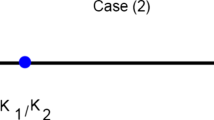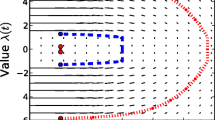Abstract
Mechanistic home range models are important tools in modeling animal dynamics in spatially complex environments. We introduce a class of stochastic models for animal movement in a habitat of varying preference. Such models interpolate between spatially implicit resource selection analysis (RSA) and advection-diffusion models, possessing these two models as limiting cases. We find a closed-form solution for the steady-state (equilibrium) probability distribution u* using a factorization of the redistribution operator into symmetric and diagonal parts. How space use is controlled by the habitat preference function w depends on the characteristic width of the animals’ redistribution kernel: when the redistribution kernel is wide relative to variation in w, u* ∝ w, whereas when it is narrow relative to variation in w, u* ∝ w 2. In addition, we analyze the behavior at discontinuities in w which occur at habitat type boundaries, and simulate the dynamics of space use given two-dimensional prey-availability data, exploring the effect of the redistribution kernel width. Our factorization allows such numerical simulations to be done extremely fast; we expect this to aid the computationally intensive task of model parameter fitting and inverse modeling.
Similar content being viewed by others
References
Arthur, S.M., Manly, B.F.J., McDonald, L.L., Garner, G.W.: Assessing habitat selection when availability changes. Ecology 77, 215–227 (1996)
Boyce, M.S., Mao, J.S., Merrill, E.M., Fortin, D.: Scale and heterogeneity in habitat selection by elk in Yellowstone National Park. Écoscience 10, 421–431 (2002)
Boyce, M.S., McDonald, L.L.: Relating populations to habitats using resource selection functions. Trends Ecol. Evolut. 14, 268–272 (1999)
Compton, B.W., Rhymer, J.M., McCollough, M.: Habitat selection by wood turtles (clemmys insculpta): and application of paired logistic regression. Ecology 83, 833–843 (2002)
Forester, J.D., Ives, A.R., Turner, M.G., Anderson, D.P., Fortin, D., Beyer, H.L., Smith, D.W., Boyce, M.S.: State-space models link elk movement patterns to landscape characteristics in Yellowstone National Park. Ecol. Monogr. 77, 285– (2007)
Fortin, D., Beyer, H.L., Boyce, M.S., Smith, D.W., Duchesne, T., Mao, J.: Wolves influence elk movements: behavior shapes a trophic cascade in Yellowstone National Park. Ecology 86, 1320–1330 (2005)
Gardiner, C.W.: Handbook of stochastic methods for physics, chemistry, and the natural sciences, 3rd edn. Springer Series in Synergetics, vol. 13. Springer, Berlin (2004)
Giuggioli, L., Abramson, G., Kenkre, V.M., Parmenter, R.R., Yates, T.L.: Theory of home range estimation from displacement measurements of animal populations. J. Theor. Biol. 240, 126–135 (2006)
Johnson, C.J., Parker, K.L., Heard, D.C., Gillingham, M.P.: A multiscale behavioral approach to understanding the movements of woodland caribou. Ecol. Appl. 12, 1840–1860 (2002)
Johnson, D.H.: The comparison of usage and availability measurementts for evaluating resource preference. Ecology 61, 65–71 (1980)
Kareiva, P.: Experimental and mathematical analyses of herbivore movement: Quantifying the influence of plant spacing and quality on foraging discrimination. Ecol. Monogr. 52, 261–282 (1982)
Lewis, M.A., White, K.A.J., Murray, J.D.: Analysis of a model for wolf territories. J. Math. Biol. 35, 749–774 (1997)
Manly, B.F.J., McDonald, L.L., Thomas, D.L., L., M.T., Erickson, W.P.: Resouce selection by animals: statistical design and analysis for field studies, 2nd edn. Kluwer, Dordrecht
Meyn, S.P., Tweedie, R.L.: Markov Chains and Stochastic Stability. Springer, London (1993)
Moorcroft, P.R.: Territoriality and carnivore home ranges. Ph.D. thesis, Dept. of Ecology and Evolutionary Biology, Princeton University (1997)
Moorcroft, P.R., Barnett, A.H.: Mechanistic home range models and resource selection analysis: a reconciliation and unification. Ecology (2007) (in press) arXiv:q-bio/0612008
Moorcroft, P.R., Lewis, M.A.: Mechanistic home range analysis. Monographs in population biology. Princeton University Press, Princeton (2006)
Moorcroft, P.R., Lewis, M.A., Crabtree, R.L.: Mechanistic home range models predict spatial patterns and dynamics of coyote territories in yellowstone. Proc. R. Soc. Ser. B 273, 1651–1659 (2006)
Okubo, A.: Diffusion and ecological problems. Springer, Heidelberg (1980)
Othmer, H., Dunbar, S.R., Alt, W.: Models of dispersion in biological systems. J. Math. Biol. 26, 263–298 (1988)
Patlak, C.: Random walk with persistence and external bias. Bull. Math. Biophys. 15, 311–338 (1953)
Press, W.H., Teukolsky, S.A., Vetterling, W.T., Flannery, B.P.: Numerical recipes in C. Cambridge University Press, Cambridge (2002)
Turchin, P.: Translating foraging movements in heterogeneous environments into the spatial distribution of foragers. Ecology 72, 1253–1266 (1991)
White, K.A.J., Lewis, M.A., Murray, J.D.: A model for wolf-pack territory formation and maintenance. J. Theor. Biol. 178, 26–43 (1996)
Author information
Authors and Affiliations
Corresponding author
Rights and permissions
About this article
Cite this article
Barnett, A.H., Moorcroft, P.R. Analytic steady-state space use patterns and rapid computations in mechanistic home range analysis. J. Math. Biol. 57, 139–159 (2008). https://doi.org/10.1007/s00285-007-0149-8
Received:
Revised:
Published:
Issue Date:
DOI: https://doi.org/10.1007/s00285-007-0149-8




